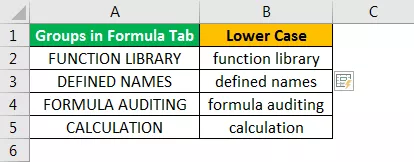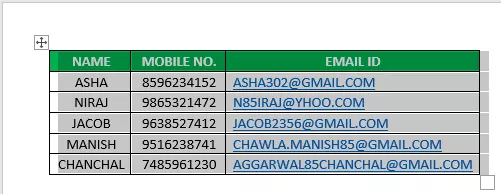Top 6 metoda za promjenu velikih i malih slova u mala slova
Postoji mnogo metoda pomoću kojih možete u tekstu Excel promijeniti velika i mala slova u mala slova. U ovom ćemo vodiču detaljno razmotriti 6 glavnih metoda za izradu velikih i malih slova.
# 1 Korištenje donje funkcije za promjenu broja slova u Excelu
U MS Excel ugrađena je funkcija za dekapitalizaciju svakog znaka u riječi, što je funkcija DONJA .
Primjer
Pretpostavimo da imamo popis nekih glagola u excelu, želimo promijeniti slučaj teksta u mala slova.

Da bismo promijenili mala i velika slova, moramo u ćeliju C2 zapisati funkciju kao '= LOWER (A2)'. ”= 'Ili' + 'koristi se za pisanje funkcije, ' DONJE ' je naziv funkcije, a A2 referenca na ćeliju za tekst za koji želimo promijeniti velika i mala slova.

Pritisnite Enter i ova će funkcija pretvoriti sva slova u tekstualnom nizu u mala slova.

Jedna vrijednost pretvara se sada. Za ostale vrijednosti možemo pritisnuti Ctrl + D nakon odabira svih ćelija s gornjom ćelijom ili pritisnuti Ctrl + C i Ctrl + V za kopiranje i lijepljenje funkcije. Ili možemo povući formulu u druge stanice da bismo dobili odgovor.

# 2 Korištenje VBA naredbenog gumba
Pomoću naredbenog gumba možemo stvoriti VBA naredbeni gumb i dodijeliti kod za promjenu sljedećeg teksta u mala slova.

Primjer
Korak 1: Da biste stvorili naredbeni gumb, kliknite naredbu "Umetni" u grupi "Kontrole" na "Razvojnoj kartici Excel". I odaberite "Naredbeni gumb".

Korak 2: Kliknite mjesto radnog lista na kojem želite da se pojavi naredbeni gumb. Pomoću gumba ALT možemo promijeniti veličinu naredbenog gumba .

Korak 3: Pomoću naredbe 'Svojstva' promijenite svojstva naredbenog gumba kao što su naslov, naziv, automatska veličina, WordWrap itd.


Korak 4: Sada, da biste naredbenom gumbu dodijelili kôd, kliknite naredbu "Pregled koda" u grupi "Kontrole" u "Razvojnom programeru". Provjerite je li aktiviran "Način dizajna" .

Korak 5: U otvorenom prozoru s padajućeg popisa odaberite "ConvertToLowerCase" .

Korak 6: Zalijepite sljedeći kod između redaka.
Kodirati:
Dim Rng As Range Dim C As Range On Error Resume Next Set Rng = Odabir za svaki c In Rng c.Value = LCase (c.Value) Next c

Korak 7: Izađite iz uređivača visual basic. Provjerite je li datoteka spremljena s ekstenzijom .xlsm jer u našoj radnoj knjižici imamo makronaredbu.
Korak 8: Deaktivirajte 'Način dizajna' . Sada, nakon odabira potrebnih ćelija, kad god kliknemo na naredbeni gumb, vrijednosti se pretvaraju u mala slova.
Odaberite sve vrijednosti iz A2: A10 i kliknite na naredbeni gumb. Tekst će se promijeniti u mala slova.
# 3 Korištenje tipke prečaca VBA
Ovaj je način sličan gore navedenom, osim činjenice da ovdje ne trebamo kreirati naredbeni gumb.
Primjer
Korak 1: Otvorite uređivač Visual Basic na kartici 'Developer' ili pomoću Excelove tipke prečaca (Alt + F11) .

Korak 2: Umetnite modul pomoću Insert Menu -> Module Command.

Korak 3: Zalijepite sljedeći kod.
Sub LowerCaseConversion() Dim Rng As Range Dim c As Range On Error Resume Next Set Rng = Selection For Each c In Rng c.Value = LCase(c.Value) Next c End Sub

Step 4: Save the file using Ctrl+S. Exit the visual basic editor. Make sure the file is saved with .xlsm extension as we have a macro in our workbook.
Step 5: Now choose the ‘Macros’ in the ‘Code’ group in the ‘Developer’ tab.

Step 6: Then click on ‘Options’ and assign the shortcut key to the Macro, and we can write a description as well.

In our case, we have assigned Ctrl+Shift+L.

Step 7: Macro is ready to use. Now to change the values into lowercase, select the required cells, and press Ctrl+Shift+L.
#4 Using Flash Fill
If we establish a pattern by typing the same value in the lowercase in the adjacent column, the Flash Fill feature will fill in the rest for us based on the pattern we provide. Let us understand this with an example.
Example
Suppose we have the following data, which we want to get in lowercase.

To do the same, we need to write the first value of the list in the lower case manually in the adjacent cell.

Come to the next cell in the same column and just press Ctrl+E.


Choose ‘Accept Suggestions’ from the box menu appeared.

That is it. We have all the values in the lower case now. Now we can copy the values, paste the same onto the original list, and delete the extra value from the right.
#5 Enter Text in Lower Case Only
We can make a restriction so that the user can enter text values in lowercase only.
Example
To do this, the steps are:
- Select the cells which you want to restrict.
- Choose ‘Data Validation’ from the ‘Data Tools’ group from the ‘Data’ tab.

- Apply the settings explained in the figure below.


- Now, whenever the user enters the value in capital letters, MS Excel will stop and will show the following message.
#6 Using Microsoft Word
In Microsoft word, unlike Excel, we have a command named ‘Change Case’ in the ‘Font’ group in the ‘Home’ tab.
Example
Suppose we have the following table of data for which we want to change the text case to ‘Lower’ Case.

To change the case, first, we will copy the data from MS Excel and paste it into MS Word. To do the same, the steps are:
Select the data from MS Excel. And press Ctrl+C to copy data from MS Excel.

Open the MS Word application and paste the table using the Ctrl+V shortcut key.

Select the table using the ‘Plus’ sign on the left-top side of the table.

Choose the ‘Change Case’ command from the ‘Font’ group and select ‘lowercase’ from the list.

Now, the data table is converted to ‘Lower.’ We can just copy the table after selecting the ‘Plus’ sign from the left top corner and paste it into Excel back.
Staru tablicu možemo izbrisati pomoću kontekstualnog izbornika, koji možemo dobiti desnim klikom na tablicu.

Stvari koje treba zapamtiti
Da bismo vrijednosti pretvorili u mala slova, ako koristimo VBA kod (gumb Naredba ili tipka prečaca), datoteku moramo spremiti s nastavkom .xlsm jer u radnoj knjizi imamo makronaredbe.












